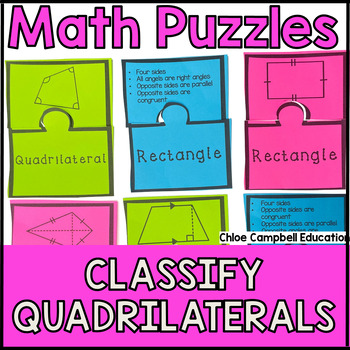Classifying quadrilaterals sounds like a very complicated concept (or at least it’s a mouthful to say!) Teaching your students how to classify a quadrilateral may require thinking outside the box…or polygon for that matter. There are so many creative and engaging ways to help your students learn how to identify and classify quadrilaterals outside of worksheets and bookwork. Here are a few of my favorite tips for teaching how to classify quadrilaterals in upper elementary classrooms.

Play Games
If you’ve been a reader of my blog for a while, you know that I use board games in my classroom whenever I can. Board games allow students to have fun while practicing skills and concepts. There are so many benefits to using board games in the classroom, including increased engagement and retention. Research by ScienceDirect actually shows that playing games in the classroom leads to an increase of 34.755% in student performance!
The Shape Attributes Math Game keeps students on their toes having them identify shape names, number of faces, vertices, and sides. This game works great in small groups or as a station during math centers. By encouraging students to solve a problem every time someone lands on the “solve a problem” space, they will gain valuable practice in identifying quadrilaterals and other shapes.
If you’re looking for a more specific game for classifying quadrilaterals, the Classifying Quadrilaterals game focuses on identifying trapezoids, rhombuses, kits, squares, parallelograms, and rectangles.
This is another great game for small groups or centers. You could also use this game as an informal assessment for students.
Playing games also presents a great opportunity for discussion when students compare their answers and possibly realize they answered differently than their classmates. Giving your students the opportunity to talk through identifying the shape and providing supporting facts for their answer allows them to think critically and articulate their knowledge.
Get Hands-On
Ensuring that your students conceptualize quadrilaterals and how to classify them can be tricky. Getting the shapes into your student’s hands so they can feel and understand the differences is so important. I like to use the Classifying Polygons hands-on activity so my students are fully immersed in classifying quadrilaterals and triangles.
This resource is great because you can use it to create a mobile, insert it into an interactive notebook, or design an entire bulletin board around it. Students love being able to hold the different shapes in their hands as they discuss the relationships between and characteristics of the different shapes.
Another way to reinforce quadrilaterals in a hands-on approach is to use pattern blocks. Although you may not find all the examples, you’ll most likely find quite a few quadrilaterals in the pattern blocks in your classroom. These small manipulatives can help students who need to physically hold and examine the shape in order to fully understand the differences between the shapes.

Use Videos and Songs
Using videos or catchy songs can sometimes help students remember complicated or confusing concepts, like classifying quadrilaterals. I sometimes use Flocabulary to introduce fun, repetitive songs and raps to my students to help them retain math information.
They have a fun rap on classifying quadrilaterals called We’ve Got Some Shapes. The songs and raps may seem a bit cheesy at first, but in no time you’ll have students humming or singing along. To be honest, you’ll probably find yourself singing the songs throughout the day!
Creating Charts & Visuals
This may seem like a very simple exercise, but it’s very impactful when implemented correctly. Creating a simple chart of the different polygons and their attributes can help your students see the relationships between the shapes and understand what makes each shape unique.
This is a great exercise to do as a whole group, perhaps on the SMARTboard or on an anchor chart so students can refer back to it as needed.
You can also assign an interactive notebook assignment to create a chart of quadrilaterals. Keep this simple and have your students either record the attributes of each shape in a chart. You can also create foldable notes for the different quadrilaterals and glue them into the notebook with their characteristics written inside.
Giving Opportunities for Individual Practice
Most of the tips I’ve shared involve whole class or small group activities. Individual practice is another great way to help students in mastering quadrilaterals. Using flashcards or a matching puzzle is a great way to give students a chance to practice on their own, at their own pace. You can print these puzzle pieces on colored cardstock and laminate so you have them year after year.
Thinking Outside The Box When Teaching How to Classify Quadrilaterals
There are so many non-traditional ways to teach how to classify a quadrilateral. My students love playing games and getting hands-on to help them understand the different characteristics. Be sure to mix-up your instruction methods and give your students plenty of opportunities to practice identifying and classifying quadrilaterals in the classroom.
If you’re looking for more tips on teaching upper elementary math, be sure to check out:
- Unique Ways to Teach Converting Measurements
- Easy Math Center Activities to Reinforce Adding and Subtracting Fractions
- Teach Math Vocabulary Terms All Year Long
What are some tips that you’d like to share with other teachers to help students understand how to classify quadrilaterals? Maybe you have a specific song or lesson that works exceptionally well in your classroom. I’d love to hear about it! Please share in the comments!





Leave a Reply